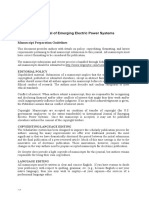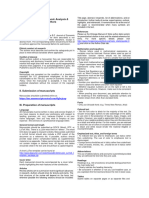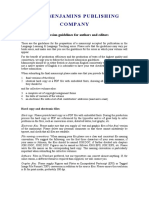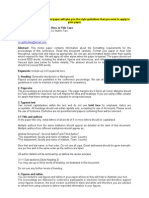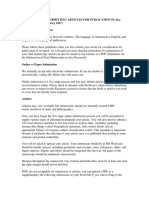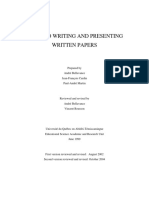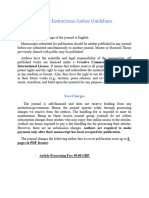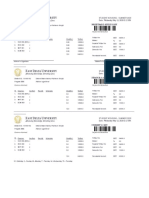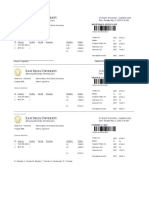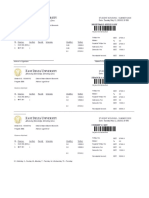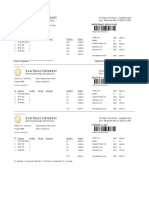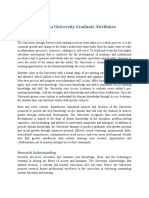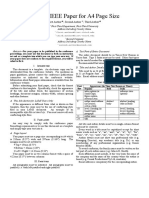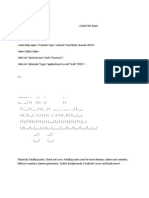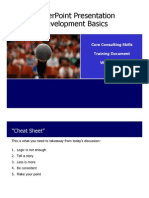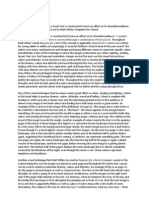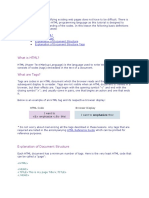MANUSCRIPT PREPARATION GUIDELINES
This document provides authors with details on policy, copyediting, formatting, and layout
requirements pertaining to final manuscript submission to this journal. All manuscripts
must have correct formatting to be considered for publication.
The manuscript submission and review process is handled through ScholarOne
Manuscripts. All manuscripts should be submitted
to http://mc.manuscriptcentral.com/dgajle.
EDITORIAL POLICY
Unpublished material: Submission of a manuscript implies that the work described is not
copyrighted, published or submitted elsewhere, except in abstract form. The
corresponding author should ensure that all authors approve the manuscript before its
submission.
Copyright: Manuscripts are accepted on condition of transfer of copyright (for U.S.
government employees: to the extent transferable) to Asian Journal of Law and
Economics. Once the manuscript is accepted, it may not be published elsewhere without
the consent of the copyright holders.
COPYEDITING/LANGUAGE EDITING
The ScholarOne system has been designed to improve the scholarly publication process
for authors. Among the many improvements we offer over traditional journals, the most
significant is that we have dramatically shortened the period between the initial
submission and the final publication of a peer-reviewed article. Much of this time savings is
due to the innovative use of electronic publication. These innovations, however, require
certain changes in the way authors need to prepare accepted manuscripts for electronic
publication.
De Gruyter does provide a light copyedit of manuscripts for this journal, but authors
remain responsible for being their own copyeditors.
LANGUAGE EDITING
All manuscripts must be written in clear and concise English. If you have reasons to doubt
your proficiency with respect to spelling, grammar, etc. (e.g., because English is not your
native language), then you may wish to employ—at your expense—the services of a
professional language editor.
Please get in touch with the Language Editors directly to discuss details.
• Alexandra Griswold
dralex321@gmail.com
Areas of expertise: public policy, political science, education, economics, social sciences,
humanities, ethics
1
�• Cyndy Brown
browncyndy@yahoo.com
Areas of expertise: political science, social sciences, humanities, ethics
• Donna Reeder
Reeder Literary Services
Areas of expertise: political science, economics, mathematical economics, natural sciences,
social sciences, technology, law, humanities, liberal arts, literary studies, health and
medicine
• Dorothy Schepps
dschepps2@gmail.com
Areas of expertise: political science, emergency management, homeland security,
community/land use planning, law, economics, cyber terrorism, and cyber security
• Jane Cotnoir
jane.cotnoir@gmail.com
Areas of expertise: Local government management, international crime and terrorism,
emergency/disaster management, humanities, social science
• Patience Kramer
patience.kramer@att.net
Areas of expertise: Health and Medicine (CAM and drug policy and analysis), Economics
and Business (with a focus on marketing)
• Steve Peter
speter@mac.com
Areas of expertise: LaTeX, Linguistics, economics, mathematics
CONTENT AND STRUCTURE
• Manuscripts should be submitted as Word, docx, rtf, or LaTex files
• If your manuscript contains special characters, equations, etc. please make sure to also
supply a PDF version as a reference file. This will be used to ensure any formatting issues
introduced during the submission process can be corrected accurately.
• Write your article in English
• Use the following document structure:
1. Introduction (titling this section is optional)
2. Subsequent sections which include tables, references to figures and figure captions.
3. Appendices (if any).
4. Explanation of symbols mentioned in the text.
5. References - Include a proper bibliography following the guidelines in the References
section below.
6. Please supply figures in separate files, not embedded in the text. Please see the “Tables,
Figures, and Graphs” section below for more detailed instructions regarding figure
submission.
BOOK REVIEWS
• Book reviews must start with the citation of the book at the top of the first page.
LATEX TEMPLATE
2
�For authors working with LaTeX files, please see the related files and documentation
at http://www.degruyter.com/staticfiles/pdfs/DeGruyter_LaTeX_template_package.zip,
including a template for author use and instructions for working with the files.
FONTS
• Only use Unicode fonts (e.g. Times New Roman, Arial)
COLORED TEXT
• Set the font color to black for the majority of the text. De Gruyter encourages authors to
take advantage of the ability to use color in the production of figures, maps, images, and
graphs. However, you need to appreciate that this will cause some of your readers
problems when they print the document on a black and white printer. For this reason, you
are advised to avoid the use of colors in situations where their translation to black and
white would render the material illegible or incomprehensible.
EMPHASIZED TEXT, TITLES, AND FOREIGN TERMS
• To indicate text you wish to emphasize, use italics rather than underlining. The use of
color to emphasize text is discouraged.
• Foreign terms should be set in italics rather than underlined.
• Titles of books, movies, etc., should be set in italics rather than underlined.
ABBREVIATIONS
The use of abbreviations and acronyms is permitted provided they are defined the first
time they are used.
HEADINGS
Headings (e.g., title of sections) should be distinguished from the main body text:
• Clearly indicate the heading hierarchy.
• Be consistent in whether or not you use headline case, or you capitalize the first word
and leave the rest in lower-case.
FOOTNOTES
• Footnotes must appear at the bottom of the page on which they are referenced rather
than at the end of the paper.
• Excessively long footnotes are better handled in an appendix.
TABLES, FIGURES & GRAPHS
• General requirements: All illustrations must be of reproduction-ready quality and in EPS,
TIF, or JPG format. They will be reduced in size to fit, whenever possible, the width of a
single column. Lettering of all figures within the article should be uniform in style
(preferably a sans serif typeface like Helvetica) and of sufficient size (ca. 8 pt.).Uppercase
letters A, B, C, etc. should be used to identify parts of multi-part figures. Cite all figures in
the text in numerical order. Indicate the approximate placement of each figure. Do not
embed figures within the text body of the manuscript; submit figures in separate files. Only
3
�figures (graphs, line drawings, photographs, etc) should be labeled as ‘figures’, not tables
or equations.
• Halftone figures (grayscale and color) should have a minimum resolution of 300 dpi and
be of good contrast. Authors are welcome to submit color illustrations. We are pleased to
offer both Print and Online publication of color figures free of charge.the services of a
professional language editor.
• Line drawings must be of reproduction-ready quality. Please note that faint shading may
be lost upon reproduction. When drawing bar graphs, use patterning instead of grey
scales. Lettering of all figures should be uniform in style. A resolution of 1200 dpi is
recommended.
• Figure legends: Provide a short descriptive title and a legend to make each figure self-
explanatory on separate pages. Explain all symbols used in the figures. Remember to use
the same abbreviations as in the text body.
• Permissions: It is the authors’ responsibility to obtain permission to reproduce original or
modified material that has been previously published. Any permissions fees are the
responsibility of the author(s).
• Offprints: The electronic files of typeset articles in Adobe Acrobat PDF format are
provided free of charge; corresponding authors receive notification that their article has
been published online. Paper offprints can be ordered in addition; an offprint order form
will accompany the page proofs and should be completed and returned with the corrected
proofs immediately.
• Please do not embed figures in the text. Instead, they should be referenced in the text
and submitted in separate files.
• Number tables consecutively using Arabic numerals. Tables should appear in the
document near where they are referenced in the text. Provide a short descriptive title,
column headings, and (if necessary) footnotes to make each table self-explanatory. Refer
to tables in the text as Table 1, 2, etc. Use Table 1, etc. in the table legends.
• Tables must not be displayed as images.
MATHEMATICS AND EQUATIONS
• Roman letters used in mathematical expressions as variables must be italicized. Roman
letters used as part of multi-letter function names should not be italicized. Subscripts and
superscripts must be a smaller font size than the main text.
• Type short mathematical expressions inline.
• Longer expressions must appear as display math, as must expressions using many
different levels (e.g., such as fractions).
• Ensure that Equations are typed or created with a plug-in, such as Word Formula Editor
or MathType. Mathematical expressions must not be displayed as images
• Important definitions or concepts can also be set off as display math.
• Number your equations sequentially.
• Insert a blank line before and after each equation.
• Whether equation numbers are on the right or left is the choice of the author(s).
However, make sure to be consistent in this.
• When proofing your document, pay particular attention to the rendering of the
mathematics, especially symbols and notation drawn from other-than-standard fonts.
REFERENCES
Please use the Chicago Manual of Style author-date system for parenthetical citation in the
text and the related reference list entry. For more specific details please
visit: http://www.chicagomanualofstyle.org/tools_citationguide.html and click on the
Author-Date tab.
4
�5

